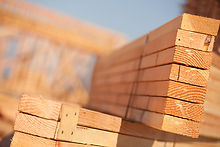
Wall Paneling
Cover your walls with wood panels to give your interiors the warmth, and make it acoustically and thermally better insulated.
The appeal of wooden wall paneling
1. Aesthetic Appeal
Wooden wall paneling adds a natural and warm aesthetic to any space. It can enhance the overall ambiance and provide a sense of comfort and coziness.
2. Versatility
Wood paneling comes in various styles, finishes, and colors, making it versatile enough to fit different design themes, from rustic to modern.
3. Insulation Properties
Wood has natural insulating properties, which can help regulate temperature and reduce energy costs by keeping spaces warmer in winter and cooler in summer.
4. Durability
When properly maintained, wooden paneling can be very durable and long-lasting, making it a worthwhile investment for home or commercial spaces.
5. Sound Absorption
Wooden panels can help absorb sound, making them a great choice for rooms where noise reduction is desired, such as offices or home theaters.
6. Easy Maintenance
Wood paneling is relatively easy to clean and maintain. Regular dusting and occasional polishing can keep it looking fresh.
7. Eco-Friendly Options
Many wooden paneling products are sourced from sustainable forests, making them an eco-friendly choice for environmentally conscious consumers.
8. Value Addition
Installing wooden paneling can increase the value of a property, as it is often seen as a high-quality and desirable feature by potential buyers.
How to Choose the Right Wood for Wall Paneling
1. Consider the Wood Species
Different wood species have varying characteristics, including color, grain pattern, and durability. Popular choices include oak, pine, cedar, and walnut. Choose a species that complements your design style.
2. Assess the Finish
The finish of the wood can significantly affect its appearance and durability. Options include natural stains, paints, or clear finishes. Consider how the finish will look in your space and its maintenance requirements.
3. Evaluate the Thickness
The thickness of the wood paneling can impact both aesthetics and insulation properties. Thicker panels may provide better insulation and a more substantial look, while thinner panels can be lighter and easier to install.
4. Check for Sustainability
Look for wood that is certified by organizations like the FSC or PEFC to ensure it is sourced sustainably. This choice supports eco-friendly practices and helps protect forests.
5. Match with Your Interior Style
Consider how the wood will fit with your existing décor. For a modern look, you might choose sleek, straight-grained woods, while rustic designs may benefit from more textured or reclaimed wood options.
6. Budget Considerations
Wood paneling can vary greatly in price depending on the species and finish. Determine your budget ahead of time and explore options that provide the best value for your investment.
7. Maintenance Needs
Different woods require different levels of maintenance. Hardwoods like oak may be more durable but require regular upkeep, while softer woods may be easier to maintain but less durable. Choose based on your willingness to maintain the panels.
8. Test Samples
Before making a final decision, request samples of the wood to see how they look in your space under different lighting conditions. This can help you visualize the final outcome and ensure you’re satisfied with your choice.





